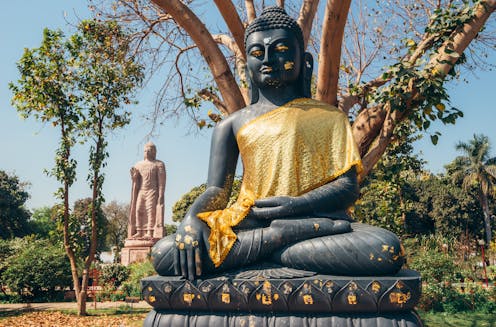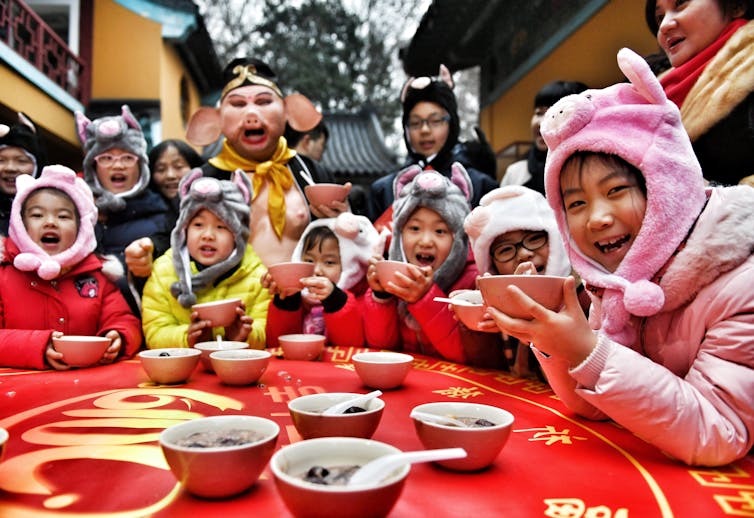On Bodhi Day, Buddhists commemorate Siddhartha Gautama’s enlightenment by lighting lamps to combat d
For Buddhists, Bodhi Day represents hope and the potential to overcome suffering.

Dec. 8 marks the celebration of Bodhi Day in Japanese Buddhism. Bodhi means enlightenment or awakening in Sanskrit. It commemorates the enlightenment of Siddhartha Gautama, who became the Buddha.
Buddhists throughout the world celebrate Bodhi Day, but they do not all celebrate Siddhartha’s enlightenment on Dec. 8. In China, South Korea and Vietnam, his enlightenment is observed on the eighth day of the 12th lunar month. In 2025, this falls on Jan. 7.
In the Theravada form of Buddhism followed in Southeast Asia, Gautama’s enlightenment is commemorated along with his birth and death during the Vesak festival celebrated in April or May. This is similar to Tibetan Buddhism, which also combines the observation of the Buddha’s birth, enlightenment and death in the springtime Saka Dawa festival.
As a scholar of Buddhism in East Asia, I study how people adapt Buddhism to their own cultural contexts. Bodhi Day is a good example of how Buddhists in different parts of Asia developed their own versions of important Buddhist holidays.
The story of Bodhi Day
No matter when Buddhists celebrate the Buddha’s enlightenment, the story behind the holiday is consistent. Biographies of the Buddha describe how young Prince Siddhartha became disillusioned with the fleeting luxuries of palace life.
He eventually left home to find a cure for the inevitable suffering caused by old age, sickness and death. Siddhartha sought guidance from various religious masters, including one who taught his students to practice extreme self-denial, such as eating only a spoonful of gruel per day.
Following this method, Siddhartha wasted away until he was just skin and bones, but he got no closer to resolving the problem of suffering. It was at just this time that a young woman named Sujata came by with milk porridge, which she offered to the skeletal Siddhartha.
This meal gave Siddhartha the energy he needed to resolve the problem of suffering once and for all. He realized that no external teacher could give him the answers he sought, and he would have to solve this problem on his own.
Siddhartha decided to meditate under a pipal tree, also known as a sacred fig tree, until he reached enlightenment. Over the next seven days he meditated, deepening his insights into the true nature of existence. On the seventh day, Siddhartha attained complete awakening to become a buddha. Buddhas are people who reach full enlightenment on their own, like Siddhartha, without direct guidance from a teacher.
Monks and nuns in Japanese and Korean Zen Buddhism follow this model by meditating intensively for the seven days leading up to Bodhi Day.
As a buddha, Siddhartha began sharing his insights with other spiritual seekers, attracting a group of followers who were the first Buddhists. Buddhist monks and merchants spread the religion to the north, east and south, and by the fourth century C.E. it was well established in China.
The Laba Festival and congee

China already had its own religious and philosophical systems, along with its own calendar of holidays, when Buddhism came onto the scene. Buddhists in China adapted their religion to Chinese language and culture, including some existing holidays.
The 12th and final month of the Chinese lunar calendar was already a time for making sacrifices for ancestors in advance of the new year. In fact, the 12th month is called La, which originally referred to the cured meat that people offered to their ancestors at this time of year. “Ba” means the number eight, so Laba translates to “the eighth day of the La month” or “eighth day of the 12th month.”
Buddhism entered China in the first century C.E. By the third century, Chinese Buddhists identified the eighth day of the 12th month as the date of the Buddha’s enlightenment. Celebrating the Buddha’s enlightenment – or Bodhi Day – at the same time as the Laba Festival required adaptation.
The Laba Festival involved meat offerings and hunting, both of which violate Buddhist rules against killing animals. Over time, a compromise emerged, and rice porridge, or congee, became this holiday’s signature food for Buddhists and non-Buddhists alike. Rice has been used in Chinese religious offerings since at least the eighth century B.C.E., and rice congee also recalls the offering of milk porridge that helped Siddhartha on his journey to Buddhahood.
Light in the darkness
Another aspect of the Laba Festival, or Bodhi Day, is that it falls around the winter solstice, the darkest part of the year.
Like other holidays at this time of year, Bodhi Day involves lighting lamps to combat the darkness. For East Asian Buddhists, these lamps symbolize the Buddha’s enlightenment, which lights the path for others to follow.
Bodhi Day is celebrated in Japan and throughout the Japanese diaspora on Dec. 8 because Japan switched from the lunar to solar calendar in 1873. Buddhists in other East Asian countries, such as China, Vietnam and South Korea, will observe Bodhi Day on Jan. 7, 2025.
East Asian Buddhists will celebrate the holiday in different ways – some by lighting lamps, some by eating congee, some others by meditating for a full week straight. But for all Buddhists, Bodhi Day represents hope and the potential to overcome suffering.
Megan Bryson does not work for, consult, own shares in or receive funding from any company or organization that would benefit from this article, and has disclosed no relevant affiliations beyond their academic appointment.
Read These Next
Rest is essential during the holidays, but it may mean getting active, not crashing on the couch
Unwinding can be hard during the holidays for many reasons. Building in time to recharge through active…
What are gas stove manufacturers trying to hide? Warning labels
The gas industry is opposed to labels that warn consumers of the potential harms of gas stoves.
America faced domestic fascists before and buried that history
Although thousands of Americans embraced fascist ideas during the interwar years, a new study examines…





